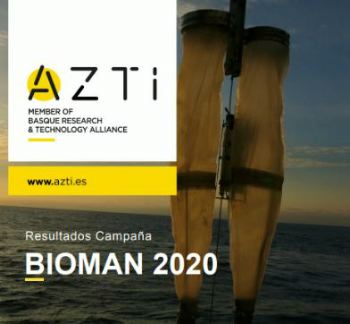|

The anchovy stock in the Bay of Biscay registers its historical maximum
 SPAIN
SPAIN
Thursday, July 02, 2020, 05:00 (GMT + 9)
- The estimate of anchovy biomass this year is around 330,000 tons, according to data from the Bioman campaign, promoted by AZTI.
- The figure, the highest since this study started in 1987, is well above the 21,000 tons that set the minimum value to guarantee the sustainability of the species.
- The anchovy catches of the Basque Country fleet have been 4,600 t and its average price at the auction has been € 1.38 / kg.
- The data on the coastal anchovy and the Bioman campaign were presented this morning at a press conference by Bittor Oroz, Deputy Minister of Agriculture, Fisheries and Food Policy of the Basque Government, and Rogelio Pozo, CEO of AZTI.
.png) The Cantabrian anchovy has great nutritional and commercial value and constitutes an essential pillar for fishing activity. As it is a species closely linked to environmental factors, it is essential to verify the existing quantity each year in order to make a sustainable management of the catches and guarantee their preservation.
To respond to this need, the AZTI technology center, a member of the Basque Research and Technology Alliance (BRTA), has carried out the Bioman scientific campaign annually since 1987, an initiative that evaluates the state of the adult anchovy population. Bioman is financed by the Deputy Ministry of Agriculture, Fisheries and Food Policy of the Basque Government and the European Commission. In addition, it has the collaboration of the General Secretary for Fisheries of the Ministry of Agriculture, Fisheries and Food, which facilitates the use of its oceanographic vessels Emma Bardán and Vizconde de Eza.
According to the latest campaign, the provisional estimate of anchovy biomass in the Bay of Biscay this year is around 330,000 tons, the highest figure in the historical series, started in 1987. These results are well above the 21,000 tons, which mark the minimum recommended value to guarantee the sustainability of the species.
While the data obtained over the past five years was already good, never since the historical series of the Bioman campaign began in 1987 had it recorded a result like this year's.
Knowledge at the service of the sector
Research for the evaluation of anchovy is a basic pillar for its management. The data collected is analyzed by the International Council for the Exploration of the Sea (ICES). Its execution contributes to the final calculation of the anchovy stock (how much there is) and to the determination of the Total Allowable Catch (TAC) (how much can be fished).
After the cancellation of the Pelgas campaign, carried out annually by the French marine research institute IFREMER, at the same time as Bioman, the only scientific data available to determine the situation of the anchovy and make the catch recommendations in 2021 will be those collected by our Bioman and Juvena campaigns, which AZTI will carry out in September, and the fleet catches.
.jpg)
This year's Bioman campaign has been a major challenge due to the covid-19 health emergency, which has required the activation of extraordinary measures to guarantee the health of the teams involved in the study. In any case, the commitment to the sustainability of one of the pillars of the economy of the Basque fishing sector and of the entire Cantabrian coast has been key to making the decision to carry out this campaign, despite the circumstances. Let's not forget that it is a sector that employs 1,000 arrantzales and 3,000 people on land, who market and transform the product to offer people healthy food.
.jpg)
In relation to this year's anchovy coastal data, catches by Basque vessels have been 4,600 tons compared to 8,500 tons in 2019, which is explained by the shorter duration of the campaign due to the incidence of the Covid-19 (this year the boats have worked for a month and a half, compared to the usual two and a half months of previous campaigns). Regarding the average price in fish market, it has also been somewhat lower: € 1.38 / kg compared to € 1.62 / kg last year.
Download the report HERE (Spanish)
|
|



